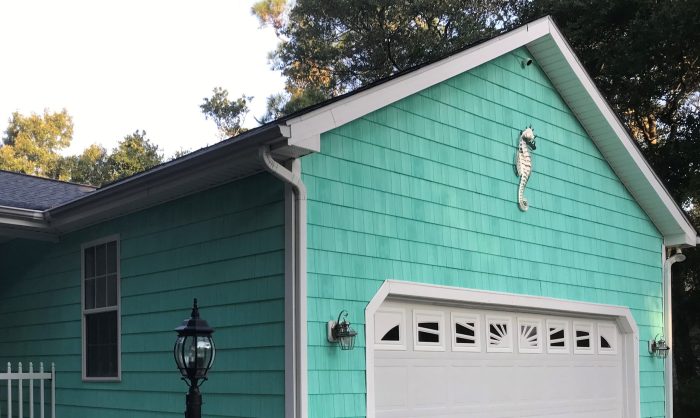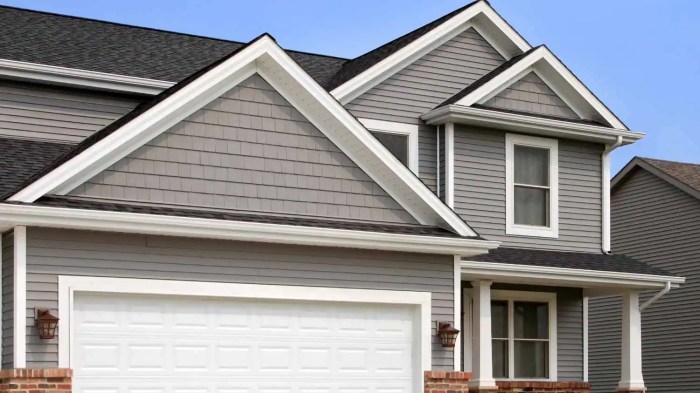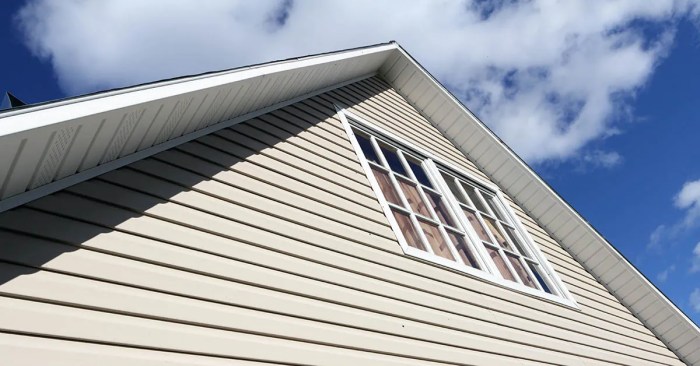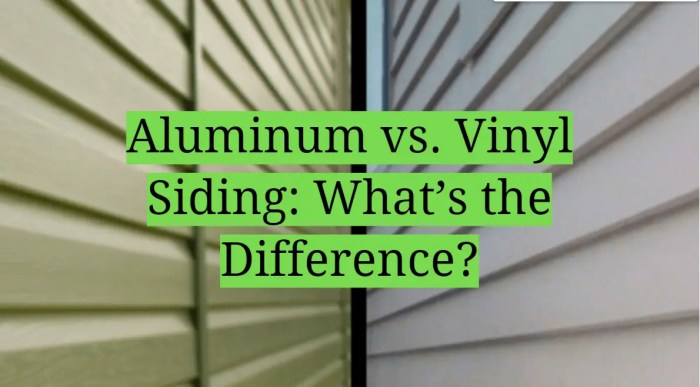Cost of Aluminum Siding vs Vinyl A Homeowners Guide

Cost of aluminum siding vs vinyl: Choosing the right siding for your home is a big decision, impacting both your wallet and your home’s curb appeal. This guide breaks down the costs—from initial materials to long-term maintenance—to help you make an informed choice. We’ll compare the upfront investment, installation expenses, and ongoing maintenance needs of both aluminum and vinyl siding, considering factors like durability, lifespan, and aesthetic options. Understanding these differences will empower you to select the siding that best suits your budget and long-term goals.
We’ll delve into the specifics of material costs, exploring the price variations within each siding type based on factors like gauge (for aluminum) and grade (for vinyl). We’ll also analyze labor costs, installation time, and DIY potential, highlighting the pros and cons of each approach. Finally, we’ll examine the long-term implications, including maintenance requirements, potential repairs, and the environmental impact of each option. By the end, you’ll have a clear understanding of which siding offers the best value for your investment.
Initial Costs

Source: factorydirectsiding.com
Choosing between aluminum and vinyl siding involves a significant upfront investment. Understanding the material costs, delivery fees, and permit requirements is crucial for accurate budgeting. This section breaks down the initial expenses for a typical 1500 sq ft house, helping you compare the two options effectively.
The total cost will vary based on several factors, including labor costs (which are not included in this comparison), regional pricing fluctuations, and the specific features you choose. Remember to always obtain multiple quotes from reputable contractors for the most accurate estimate for your project.
Material Costs for a 1500 sq ft House
Let’s assume a standard 1500 sq ft house requiring approximately 15 squares (1 square = 100 sq ft) of siding. Material costs will vary depending on the chosen siding type and quality. Delivery fees can range from $100 to $500 depending on location and supplier. Permit costs are location-specific and can vary widely; expect to pay anywhere from $100 to $1000 or more, depending on your local regulations.
For this example, we’ll use estimated average prices. Keep in mind that these are broad estimates and actual costs may differ significantly. Always consult local suppliers for accurate pricing in your area.
Estimated Material Costs (15 squares):
- Aluminum Siding (mid-range): $3,000 – $5,000 (materials) + $200 – $400 (delivery)
- Vinyl Siding (mid-range): $2,000 – $4,000 (materials) + $100 – $300 (delivery)
Aluminum Siding Price Variations
The price of aluminum siding is heavily influenced by its gauge (thickness) and finish. Thicker gauges are more durable and expensive, while different finishes (e.g., painted, textured) also affect cost.
| Gauge | Finish | Price per Square Foot | Notes |
|---|---|---|---|
| .032 inch | Painted | $2.50 – $4.00 | Common gauge, offers good durability |
| .040 inch | Painted | $3.50 – $5.00 | Thicker, more durable, higher cost |
| .032 inch | Woodgrain textured | $3.00 – $4.50 | More expensive due to added texture |
| .040 inch | Anodized | $4.00 – $6.00 | Premium finish, highly durable, most expensive |
Vinyl Siding Price Variations
Vinyl siding prices vary based on thickness, style, and warranty. Thicker vinyl generally indicates better durability and longevity. Longer warranties often reflect higher initial costs but offer peace of mind.
- Standard Vinyl Siding (thin gauge, shorter warranty): $1.00 – $2.00 per square foot. Often comes with a 10-year warranty.
- Mid-Grade Vinyl Siding (medium gauge, longer warranty): $2.00 – $3.00 per square foot. Typically offers a 20-year or more warranty.
- Premium Vinyl Siding (thick gauge, longest warranty): $3.00 – $4.00+ per square foot. Features thicker panels, enhanced durability, and often includes a lifetime warranty.
Installation Costs
Getting your new siding installed involves more than just the materials; labor costs and the time it takes to complete the job are significant factors influencing the overall expense. This section will break down the installation costs for both aluminum and vinyl siding, considering factors like house size and project complexity.
Labor Costs for Aluminum and Vinyl Siding Installation
Labor costs vary significantly depending on several factors. The size of your house is a primary driver – a larger house naturally requires more time and therefore, more labor. The complexity of the job also plays a crucial role. Houses with intricate architectural details, multiple gables, or dormers will necessitate more precise work and thus, a higher labor cost. The installer’s experience and location also affect pricing; experienced installers in high-demand areas typically charge more. Generally, you can expect to pay an hourly rate or a per-square-foot rate for installation. For example, you might see rates ranging from $3 to $8 per square foot for labor, with the higher end reflecting more complex projects or premium installers.
Installation Time Comparison: Aluminum vs. Vinyl Siding
The installation time for both aluminum and vinyl siding is influenced by the house size, weather conditions, and the installer’s expertise. Aluminum siding, generally requiring more precise cuts and fastening, tends to take slightly longer to install than vinyl siding. Unfavorable weather, such as rain or extreme heat, can also significantly delay the project.
| Siding Type | Small House (1000 sq ft) | Medium House (2000 sq ft) | Large House (3000 sq ft) |
|---|---|---|---|
| Aluminum | 2-3 days | 4-6 days | 6-9 days |
| Vinyl | 1-2 days | 3-5 days | 5-7 days |
Note: These are estimates, and actual installation time may vary based on the factors mentioned above. For instance, a particularly complex house design or unexpected issues during installation could add extra days to the project.
DIY Installation: Aluminum and Vinyl Siding
While both aluminum and vinyl siding can be DIY projects, they present different levels of difficulty. Vinyl siding is generally considered easier for DIY installation due to its simpler interlocking system and more forgiving nature. Aluminum siding, on the other hand, demands more precision in cutting and fastening to avoid damage.
Tools and Skills Needed for DIY Installation
For both types of siding, you’ll need basic tools like a measuring tape, level, saw, hammer, and drill. However, aluminum siding installation requires more specialized tools such as metal snips and possibly a rivet gun. Furthermore, aluminum siding installation requires a more skilled approach to handle the material’s rigidity and potential for damage. For vinyl, the skills needed are less demanding but still require attention to detail to ensure a proper and weather-tight installation.
Potential Cost Savings and Risks of DIY Installation
The primary advantage of DIY installation is the potential cost savings on labor. However, it’s crucial to weigh this against the risks. Improper installation can lead to damage to the siding, water leaks, and even structural problems, resulting in costly repairs later on. For a large or complex project, the time investment for a DIY project can also be substantial, potentially negating any cost savings if you are not efficient. Therefore, carefully assess your skills and the complexity of your project before attempting a DIY installation. If you are uncertain about your abilities, it is always recommended to hire a professional installer.
Long-Term Costs

Source: angi.com
Choosing between aluminum and vinyl siding involves considering not just upfront costs, but also the long-term expenses associated with maintenance and repairs. While both materials are relatively low-maintenance compared to other siding options, there are key differences that affect your budget over the lifespan of your home. Understanding these differences will help you make an informed decision.
Maintenance and Repair Requirements
This section compares the maintenance needs and typical repair costs for aluminum and vinyl siding. Regular maintenance can significantly extend the life of your siding and prevent costly repairs down the line.
| Maintenance Task | Aluminum Siding Frequency & Cost | Vinyl Siding Frequency & Cost |
|---|---|---|
| Cleaning | Annually; $50-$150 (depending on house size and pressure washing needs) | Annually or Bi-annually; $50-$150 (depending on house size and cleaning method) |
| Caulk Repair | Every 5-7 years; $100-$300 (depending on the extent of repairs) | Every 5-7 years; $100-$300 (depending on the extent of repairs) |
| Painting (if desired) | Every 10-15 years; $1000-$3000+ (depending on house size and paint quality) | Generally not required; Minor touch-ups may be needed occasionally at minimal cost. |
| Inspection for Damage | Annually; Minimal cost (visual inspection) | Annually; Minimal cost (visual inspection) |
Repair Costs
Damage to siding can occur from various sources like hailstorms, impacts from falling branches, or simply general wear and tear. The cost of repair varies depending on the extent of the damage and the material involved.
Aluminum siding repairs often involve replacing individual panels or sections. For example, replacing a damaged 10ft section might cost between $100-$200 for the material and $50-$100 for labor, depending on accessibility. More extensive damage might require professional assessment and a higher cost. Dents in aluminum siding are often repairable by careful hammering and refinishing.
Vinyl siding repairs are generally less expensive than aluminum, as individual panels are relatively inexpensive to replace. Replacing a damaged vinyl panel could cost $20-$50 for the material and $25-$75 for labor. However, major damage to a large area can still become costly. Cracked or severely damaged vinyl panels will require replacement.
Potential Hidden Costs
Over the lifetime of your siding, unforeseen expenses can arise. For aluminum siding, corrosion due to prolonged exposure to moisture or harsh chemicals (near coastal areas for example) can lead to premature deterioration and costly replacement of panels. The need for repainting aluminum siding every decade or so also represents a significant long-term cost.
For vinyl siding, while it doesn’t rust, prolonged UV exposure can lead to fading and embrittlement. This might not necessitate immediate replacement, but it can impact the curb appeal and overall value of your home. Furthermore, improper installation of vinyl siding can lead to issues like water damage behind the panels, leading to costly repairs involving mold remediation and structural work. These hidden costs highlight the importance of hiring a qualified and experienced installer for both types of siding.
Longevity and Durability

Source: crownremodelingllc.com
Choosing between aluminum and vinyl siding involves considering their long-term performance. Both materials offer decent lifespans, but their durability varies depending on the climate and specific product quality. Understanding these differences is crucial for making an informed decision that aligns with your budget and long-term goals.
The lifespan of siding is significantly impacted by environmental factors. Harsh weather conditions accelerate deterioration, while milder climates allow for longer service life. Manufacturing quality also plays a key role, with higher-grade materials and construction generally leading to greater longevity.
Expected Lifespan by Climate, Cost of aluminum siding vs vinyl
The table below provides estimates for the lifespan of aluminum and vinyl siding under different climatic conditions. These are averages and actual lifespans can vary based on installation quality, maintenance, and the specific product used.
| Siding Type | Hot/Humid Climate | Cold/Snowy Climate | Mild Climate |
|---|---|---|---|
| Aluminum | 40-50 years | 50-60 years | 60+ years |
| Vinyl | 25-35 years | 30-40 years | 40+ years |
Durability Against Weather Elements
Aluminum and vinyl siding each possess unique strengths and weaknesses when facing various weather challenges. Understanding these characteristics is essential for determining which material best suits your specific needs and location.
- Aluminum Siding:
- Strengths: Highly resistant to wind damage, hail impact, and insect infestation. It’s also non-combustible and offers good protection against fire.
- Weaknesses: Can dent or scratch more easily than vinyl. Susceptible to corrosion in coastal areas or environments with high salinity. Can fade slightly over time due to UV exposure, though less so than some vinyl siding.
- Vinyl Siding:
- Strengths: Resistant to moisture, rot, and insect damage. Generally less expensive upfront than aluminum.
- Weaknesses: More susceptible to damage from strong winds and hail. Can become brittle and crack in extremely cold temperatures. Prone to fading and discoloration from prolonged UV exposure. Can warp or melt under intense heat.
Impact of Manufacturing Processes and Materials
The manufacturing process and the quality of materials used significantly affect the longevity and durability of both aluminum and vinyl siding. Variations in thickness, coatings, and additives can lead to considerable differences in performance.
- Aluminum Siding: Higher-gauge aluminum (thicker) is more resistant to dents and damage. Powder-coated finishes offer superior protection against UV degradation and corrosion compared to painted finishes. The quality of the alloy used also impacts its overall strength and resistance to corrosion.
- Vinyl Siding: The thickness of the vinyl, the presence of UV inhibitors, and the type of resin used all influence the siding’s resistance to fading, cracking, and warping. Higher-quality vinyl siding often incorporates impact modifiers to enhance its resistance to hail and other physical impacts. A reputable manufacturer’s warranty can be an indicator of quality.
Aesthetic Considerations and Customization Options: Cost Of Aluminum Siding Vs Vinyl
Choosing between aluminum and vinyl siding involves more than just cost; the aesthetic impact on your home’s appearance and overall curb appeal is a significant factor. Both materials offer a range of colors and styles, but their customization options and how they visually complement different architectural styles vary considerably.
Color and Style Options for Aluminum and Vinyl Siding
Aluminum siding traditionally offered a more limited color palette, often featuring muted earth tones or metallic shades. However, modern advancements have expanded the options, including various shades of white, beige, gray, and even some bolder colors. While aluminum can achieve a sleek, modern look, its color options often lack the depth and richness found in vinyl. Vinyl, on the other hand, boasts an extensive color range, from classic whites and creams to vibrant reds, blues, and greens, mimicking wood grain, stone, or even brick textures. This allows for greater flexibility in matching existing architectural elements or creating a unique visual style. For example, a deep navy vinyl siding could create a dramatic contrast against white trim, while a light gray aluminum siding might suit a contemporary design. Customization options are generally greater with vinyl, as it can often be molded to imitate more complex textures and patterns.
Aluminum and Vinyl Siding on Different House Styles
The visual impact of aluminum and vinyl siding varies significantly depending on the house style. A craftsman-style home might look charming with vinyl siding that imitates the look of wood clapboard, providing a warm and inviting feel. In contrast, a ranch-style home might be better suited to the clean lines and smooth surface of aluminum siding, enhancing its modern appeal. A Victorian home, with its intricate details, might be best complemented by vinyl siding that can better replicate the richness of wood or stone textures. Conversely, a minimalist modern home might look best with the sleek, unadorned look of aluminum siding. The visual integration of the siding with the architectural details, such as windows, doors, and trim, is crucial. For instance, a light-colored vinyl siding might clash with dark-colored windows on a colonial-style home, while a dark-colored aluminum siding might overwhelm a small cottage.
Impact on Curb Appeal and Property Value
The choice of siding significantly influences a home’s curb appeal and, consequently, its property value. High-quality, well-maintained siding enhances a home’s visual attractiveness, making it more appealing to potential buyers. Vinyl siding, with its vast array of colors and textures, offers more opportunities to create a visually appealing exterior, potentially boosting curb appeal. However, poorly installed or low-quality vinyl siding can detract from the overall aesthetic and reduce property value. Aluminum siding, if chosen correctly and installed expertly, can provide a clean and modern look, adding value to contemporary homes. However, its more limited color and texture options might restrict its ability to enhance the curb appeal of homes with more traditional styles. Factors such as the overall condition of the home, landscaping, and the neighborhood also play a role in determining the impact of siding choice on property value. A well-maintained home with attractive siding in a desirable neighborhood will generally command a higher price than a similarly sized home with outdated or damaged siding.
Environmental Impact

Source: homeprofy.com
Choosing between aluminum and vinyl siding involves considering their respective environmental footprints. Both materials have impacts throughout their lifecycles, from raw material extraction and manufacturing to transportation, installation, and eventual disposal or recycling. Understanding these differences can help homeowners make informed decisions aligned with their environmental priorities.
Aluminum and vinyl siding present distinct environmental profiles across their life cycles. The manufacturing process for each material consumes different resources and generates varying levels of pollution. Transportation distances also influence carbon emissions, while disposal and recycling options vary significantly. A comprehensive comparison is crucial for evaluating the overall environmental impact.
Manufacturing and Transportation
The manufacturing of aluminum is energy-intensive, requiring significant electricity to extract aluminum from bauxite ore and process it into siding. This process generates greenhouse gas emissions. Vinyl siding production, while less energy-intensive than aluminum, relies on petroleum-based polymers, contributing to carbon emissions and potential air pollution. Transportation distances for both materials also affect their carbon footprint; siding sourced locally generally has a smaller environmental impact than that shipped across long distances.
Lifecycle Environmental Footprint Comparison
The following table summarizes the relative environmental impact of aluminum and vinyl siding across their lifecycle stages:
| Stage | Aluminum Siding | Vinyl Siding |
|---|---|---|
| Manufacturing | High energy consumption, greenhouse gas emissions | Moderate energy consumption, reliance on fossil fuels, potential air pollution |
| Transportation | Variable, depending on distance | Variable, depending on distance |
| Installation | Relatively low impact | Relatively low impact |
| Disposal/Recycling | High recyclability rate, but requires specialized facilities | Low recyclability rate, often ends up in landfills |
| Longevity | Long lifespan, reducing the need for frequent replacements | Moderate lifespan, potentially requiring more frequent replacements |
Recyclability
Aluminum siding boasts a significantly higher recyclability rate compared to vinyl siding. Aluminum can be repeatedly melted down and reused with minimal loss of properties. Recycling aluminum reduces the need for new bauxite mining, lowering energy consumption and greenhouse gas emissions associated with primary aluminum production. However, access to aluminum recycling facilities might be limited in certain areas. In contrast, vinyl siding’s recyclability is low. While some vinyl can be recycled, the process is often complex and economically unviable, leading to a large portion ending up in landfills. The recycling process for vinyl often involves downcycling, where the material is converted into lower-grade products, limiting its reuse potential.
Energy Efficiency
Both aluminum and vinyl siding can contribute to a building’s energy efficiency, but in different ways. Aluminum siding’s high reflectivity can help reduce heat absorption during summer months, lowering cooling loads. However, aluminum itself is a good conductor of heat, so proper insulation is crucial to prevent heat loss in winter. Vinyl siding, while less reflective than aluminum, can be manufactured with insulating properties. The overall energy efficiency contribution depends heavily on factors like insulation levels in the wall assembly and the climate. For instance, in regions with hot summers and mild winters, aluminum’s reflectivity might offer a greater advantage, while in areas with cold winters, vinyl siding with insulation might be more beneficial.
Final Thoughts
Ultimately, the best siding choice depends on your priorities and budget. While vinyl siding often presents a lower initial cost and easier DIY installation, aluminum siding boasts superior durability and longevity. Carefully weigh the pros and cons of each material, considering factors like your climate, home style, and long-term maintenance preferences. By thoroughly evaluating these aspects, you can confidently select the siding that provides the best balance of cost-effectiveness, aesthetic appeal, and lasting value for your home.
Question Bank
What about insurance considerations for different siding types?
Insurance premiums might be slightly affected by siding choice, but it’s usually not a major factor. Fire-resistant materials might offer minor discounts in some areas.
Can I mix and match aluminum and vinyl siding on my house?
It’s generally not recommended. The materials expand and contract differently, leading to potential issues with seams and aesthetics over time.
How does siding choice affect my home’s energy efficiency?
Both aluminum and vinyl can be energy-efficient, depending on the insulation underneath. Aluminum reflects heat better, while some vinyl options offer insulation features.
What are the warranty options for aluminum and vinyl siding?
Warranties vary widely by manufacturer and product. Always check the specific warranty details before making a purchase. Aluminum warranties often focus on material defects, while vinyl warranties might cover both material and labor.
Comments are closed.